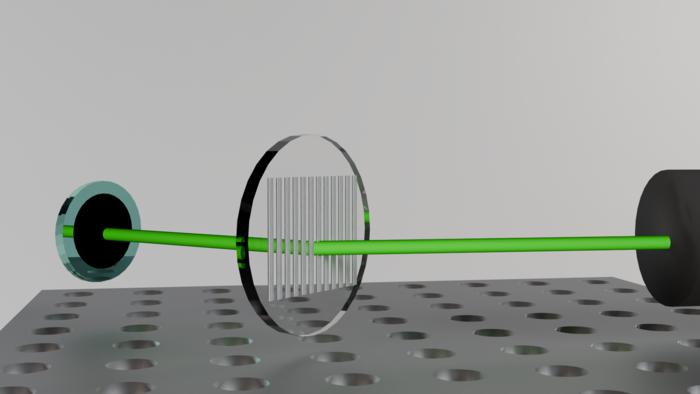In recent years, the field of optics has experienced a paradigm shift, driven largely by the development of metasurfaces. These innovative optical components are poised to revolutionize how light is manipulated across various applications, making them significantly smaller, lighter, and more efficient compared to traditional optical elements like lenses and gratings. At the forefront of this transformative research is Dr. Maryna Leonidivna Meretska, a leading figure at the Karlsruhe Institute of Technology (KIT), who is pioneering advanced optical techniques that leverage the unique properties of these metasurfaces.
Conventional optical components, such as curved lenses, rely on the principle of refraction to direct light. These components, typically made from glass or plastic, often become cumbersome due to their size and weight. In stark contrast, metasurfaces are flat and consist of an array of precisely engineered structures, known as meta-atoms. These meta-atoms have the remarkable ability to manipulate light on a subwavelength scale, enabling unprecedented precision in controlling various light properties—specifically phase, amplitude, and polarization. This level of control facilitates significant advancements in optical technologies.
Dr. Meretska emphasizes the potential of metasurfaces to allow users to influence not just the direction but also the intensity and oscillation of light waves in a highly tailored manner. What makes metasurfaces particularly exciting is their capacity for multiplex control. This means that a single metasurface can potentially replace multiple traditional optical components, leading to a reduction in the overall size of optical systems without compromising their performance. This capability not only streamlines optical setups but also paves the way for innovative applications in various fields.
One significant advantage of metasurfaces is their manufacturability. Dr. Meretska points out that the fabrication of these advanced optical components can be achieved through techniques borrowed from the semiconductor industry, such as advanced lithography and etching. This suggests that scalable production methods are well within reach, facilitating broader implementation of metasurfaces across multiple industries, including telecommunications, medical imaging, and consumer electronics.
During the upcoming Hannover Messe trade fair, Dr. Meretska and her team will unveil their cutting-edge optical diffraction meta-grating designed using specially developed equipment at KIT. Diffraction gratings, crucial elements in optical systems, typically suffer from decreased efficiency as the angle of incidence increases—a limitation that traditional optical components have grappled with for years. Their meta-grating, however, boasts an astonishing fourfold increase in efficiency over conventional systems, significantly improving light manipulation under challenging conditions.
The implications of this newfound efficiency are far-reaching, enhancing light control integral to various applications. For instance, in spectroscopy, telecommunications, and laser systems, where precise light management is paramount, the meta-grating developed at KIT represents a substantial leap forward. This innovative technology opens avenues for future deployments, allowing researchers and industry professionals to develop tailored optical solutions that meet the specific needs of various applications.
The versatility of meta-optics extends beyond industrial applications. Their flat structure provides significant advantages in the realms of camera systems, sensors, and augmented-reality displays. As the demand for miniaturized technologies continues to rise, the introduction of meta-optical components in these applications can lead to enhanced functionality without the usual trade-offs in size or quality. Additionally, sectors like robotics and autonomous driving stand to gain significantly, as the advancements made possible by meta-optics improve object recognition capabilities critical to their operation.
In summary, the innovations arising from the study of metasurfaces encapsulate an exciting frontier in optics. With their ability to streamline optical systems, boost efficiency, and reduce manufacturing complexity, metasurfaces offer a glimpse into a future where powerful optical tools are compact and accessible. The applications are as diverse as the technologies themselves, promising to enhance various industries and improve the quality of numerous technologies that rely on precise light control.
As research continues, experts anticipate a flurry of new developments in the field of meta-optics, heralding a new age of optical engineering characterized by enhanced functionalities, more efficient systems, and research breakthroughs that could revolutionize countless applications, weaving meta-optics firmly into the fabric of tomorrow’s technological landscape.
Subject of Research: Development and applications of metasurfaces in optical technologies
Article Title: Revolutionizing Light Manipulation: The Future of Metasurfaces
News Publication Date: [Not provided]
Web References: [Not provided]
References: [Not provided]
Image Credits: Dr. Maryna Leonidivna Meretska
Keywords
Metasurfaces, optics, light control, Dr. Maryna Leonidivna Meretska, Karlsruhe Institute of Technology, optical components, diffraction gratings, advanced manufacturing, telecommunications, augmented reality, robotics, efficiency.
Tags: advanced optical techniquesapplications of metasurfacesDr. Maryna Meretska researchefficiency in optical systemsinnovative optical componentslight manipulation technologiesmeta-opticsmetasurfaces in opticsoptical phase and amplitude controlrevolutionizing optical technologiessubwavelength light controltraditional lenses vs metasurfaces





